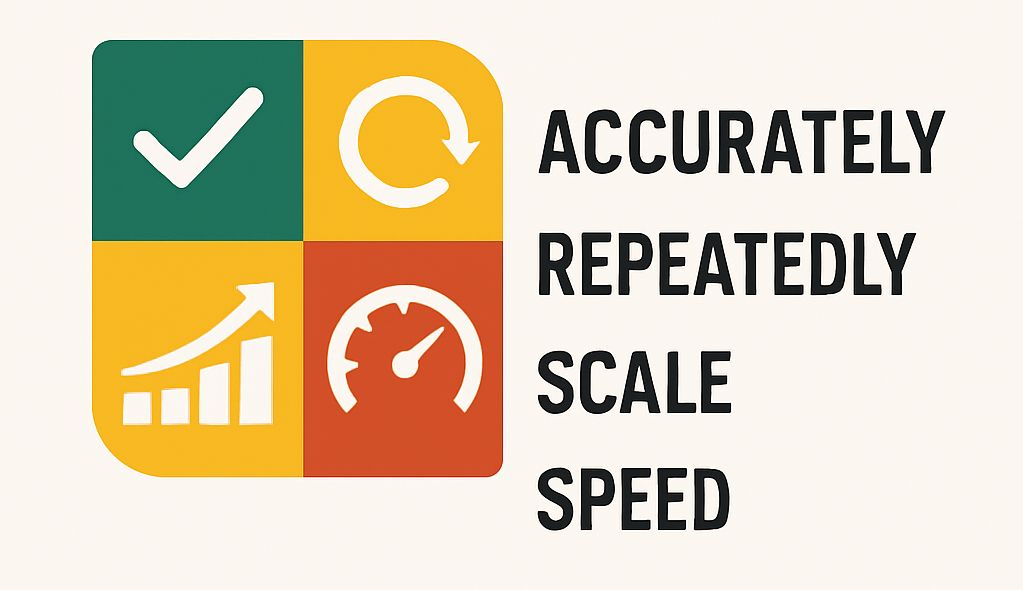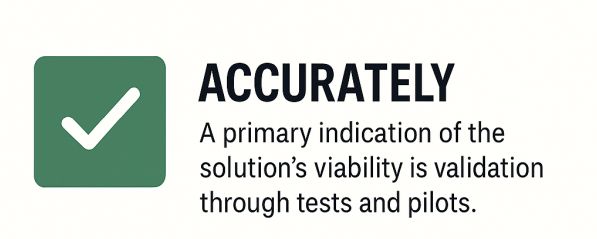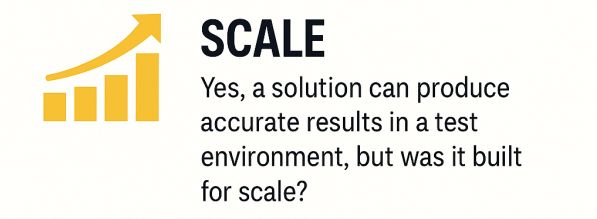
Delivering Category Management, Accurately, Repeatedly at Scale and Speed
Over time, I realized that every promising innovative solution with a potential ROI I evaluated, whether a data platform, an AI engine, or an in-store robot, ultimately succeeded or failed based on four criteria: Accuracy, Repeatability, Scalability, and Speed. If it failed even one, it wasn’t ready.
Category Management’s Evolution & Shortcomings
Category Management, now more than thirty years old, stood the test of time and stayed relevant as the steps and processes to get products successfully to the shelf, collaboratively. While we saw fluctuations in its prioritization as a process and tool, what ultimately failed it over time were the solutions that fell short of delivering on its full promise.
Lessons From Past Tools
The process has long relied heavily on historical data and research to drive solution usage. From chain-level sales, to cluster, and then to store-level, moving from monthly to weekly and eventually daily reporting, it’s mostly been the same type of data; just a lot more of it. Dealing with that granular data and large volume presented a challenge.
The Modern Retail Tech Landscape
Advancements in technology, computing power, and Artificial Intelligence(AI) are making it possible to deliver better assortments that meet shopper expectations. Solution providers are all scrambling to improve their capabilities and meet these expectations. Differentiation is key, as AI and all its derivatives are starting to level the playing field in capabilities.
The focus should shift to delivering better, faster, and cheaper. Risk aversion and groupthink are slowing decision-making. Transitioning from legacy comprehensive approaches to new fragmented solutions involves significant risks and requires careful change management.
Introducing the ARS² KPIs
After several rounds of product development in my rearview mirror, I realized the challenges the industry faces when assessing new solutions. There is a need to cut through hype and short-lived trends, and focus on the real problems we aim to solve. Consequently, I identified four key measures to use in the early stages when evaluating new solutions: delivering Accurately, Repeatedly, at Scale, and with Speed. It became ingrained in my thinking to automatically cycle through these KPIs to assess a solution’s validity and maturity.
Use Case: When Hype Overwhelmed Evaluation
These KPIs became evident when I was involved in developing a robotic solution for retail stores, where a robot navigates the stores, captures images of shelf conditions, and processes the content to report on shelf status in near real-time.
At the time, it was early days, and the idea of a robot collecting data captured the attention and fascination of the industry. To the extent that we overlooked key details. For this, I will use the robotic solution as an example use case for these KPI’s, but truly they apply to category management solutions and beyond.

Accurately
A primary indication of the solution’s viability is validation through tests and pilots. It confirms whether the solution provides real, reliable results for decision-making and measuring impact. For the robot, the insights extracted from imagery should accurately reflect shelf conditions. Details such as product information down to the UPC level, location on the shelf, and store are examples of what to test to measure the solution’s accuracy. A strong solution not only delivers accurate results in a pilot, but proves its reliability when exposed to the messy edge cases of live retail environments.

Repeatedly
Once accuracy is demonstrated, consistency becomes essential. Do we obtain the same results with repeated scans of the shelf? Is slight deviation from the path caused by traffic and obstructions leading to invalid results? How does the robot identify the obstruction and recover to produce the necessary results accurately?

Scale
This is where it becomes challenging and where most solutions start to fall short. Yes, a solution can produce accurate results in a test environment, but was it built for scale? Especially in retail, with increasing numbers of stores and larger store sizes, were the back-end systems designed from the beginning to scale? The robot can easily scan a few aisles, but can it scan entire stores, address different fixtures and displays? Would the battery support large store scans adequately? Can the solution be rolled out to cover the entire store and hundreds, if not thousands, of stores in large chains? This is where reality sets in, and expectations need adjustment. A long-term view of the solution’s viability and readiness for a large rollout must be considered and planned from day one. Cost is another factor for scale—at what price does the solution deliver enough value to justify adoption? Does it provide enough benefit?

Speed
Speed is the final and often most underestimated component. Can the solution collect, process, and deliver accurately and repeatedly at scale to positively impact the business effectively? There are countless solutions in the retail graveyard of abandoned tools dismissed due to challenges in delivering timely results to prove relevant.
Why ARS², Not AR2S?
In this framework, it’s the “S” that’s repeated “Scale and Speed” which is why ARS² fits perfectly. It’s not just clever notation; it reflects how critical those two factors are in retail environments. The visual symmetry reinforces the idea that a solution must not only work well, but do so repeatedly and under pressure.
ARS² isn’t just an acronym; it’s a filter.
Some have proposed the acronym RASP, but I believe ARS² more accurately reflects the real-world progression of trust-building in innovation. Accuracy must come first; get it right before you scale or accelerate. The visual symmetry of ARS² isn’t just clever; it’s a reflection of what truly matters in retail tech evaluation.
Why This Framework Matters Now
With the advent of AI and now more precisely Agentic AI, the solution field is being deeply disrupted at lightning speed. Advances will be rapid, and the number of solutions to consider will grow. That is why we need a mechanism in place, early on, to filter relevant solutions that solve real problems and generate value from the short-lived ones. This is where Accurately, Repeatedly at Scale, and Speed become invaluable tools early in the process to weed out the noise and allow you to focus on relevant solutions for your business.
It’s a Matter of Trust
Building, and in many cases restoring, trust is essential to establishing credibility in the retail tech ecosystem. After decades of over-promising and under-delivering, stakeholders have become rightfully skeptical and overwhelmed when evaluating new solutions. The four KPIs provide a clear path forward: a transparent, measurable framework to guide innovation along a trackable journey toward maturity, value, and scalable adoption.
By setting clear expectations from the beginning, this framework becomes more than just a filter; it’s a tool for rebuilding trust. It shifts the focus from flashy demos to consistent performance. Innovation alone won’t secure success; the next generation of winners will combine meaningful breakthroughs with collaborative partnerships, service, and accountability.
The question now is: who will lead the way? Who will be the new standard-bearers of trust and delivery in our industry?
Are you ready?

